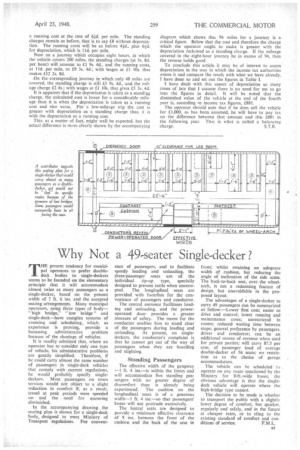Why Not a 49-seater Single-decker ?
Page 35

If you've noticed an error in this article please click here to report it so we can fix it.
THE present tendency for municipal operators to prefer doubledeck bodies to single-deckers seems to be founded on the elementary principle that it will accommodate almost twice as many passengers as a single-decker, based on the present width of 7 ft. 6 ins. and the accepted seating arrangements. Many municipal operators, using three types of body" high bridge," "low bridge" and single-deck—have complex systems of routeing and scheduling,, which, as experience is proving, provide a harassing administrative problem because of the shortage of vehicles.
It is readily admitted that, where an operator has to -consider only one type of vehicle, his administrative problems are greatly simplified. Therefore, if he could carry almost the same number of passengers in single-deck vehicles that comply with current regulations. he would probably specify singledeck era. Most passengers on town services would not object to a slight reduction in comfort if, as a result, travel at peak periods were speeded un and the need for queueing diminished.
In the accompanying drawing the seating plan is shown for a single-deck body, designed to meet Ministry of Transport regulations. For conveni
ence of passengers, and to facilitate speedy loading and unloading, the three-passenger seats are of the individual tip-up type, specially designed to prevent rattle when unoccupied. The longitudinal seats are provided with footrests for the convenience of passengers and conductor.
The central entrance facilitates loading and unloading, and the poweroperated door provides a greater measure of safety. The recess for the conductor enables him to stand clear of the passengers during loading and unloading. At present, on singledeckers, the conductor's complaint is that he cannot get out of the way of passengers when they are boarding and alighting.
Standing Passengers
The effective width of the gangway —1 ft. 4 ins.—is within the limits and will accommodate five standing passengers with no greater degree of discomfort than is already being' experienced. The cushion on the longitudinal seats is of a generous width—I ft. 4 ins.—so that passengers' knees will not protrude excessively.
The lateral seats are designed to provide a minimum effective clearance of 9 ins, between the front of the cushion and the back of the seat in
front; whilst retaining an adequate width of cushion, but reducing the angle of inclination of the side arms. .The back-to-back seat, over-the wheelarch, is. not a redeeming feature of design, but unavoidable in the proposed layout.
The advantages of a single-decker to carry 49 passengers can be summarized as' follow:—Lower first cost; easier to drive and control; lower running and maintenance costs; unrestricted in routes; reduced waiting time between stops; general preference by passengers, driver and conductor; can be an additional source of revenue when used for private parties; will carry 87.5 per cent, of passenger load of average double-decker of 56 seats; no restriction as to the choice of garage accommodation.
The vehicle can be scheduled to , operate on any route sanctioned by the Ministry for 8-ft.-wide buses; the obvious advantage is that the singledeck vehicle will operate where the high-bridge type cannot.
The decision to be made is whether to transport the public with a slightly lower degree of comfort, but quicker, regularly and safely, and in the future at cheaper rates, or to cling to the existing standard of comfort and con ditions of service. F.M.L.












































































